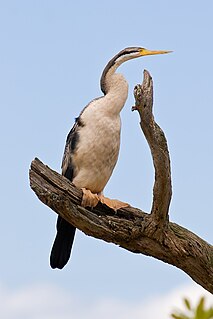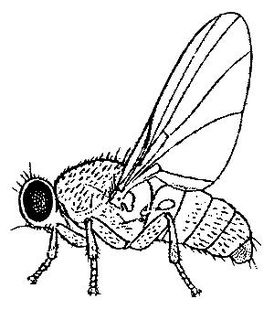
The bird family Petroicidae includes 49 species in 19 genera. All are endemic to Australasia: New Guinea, Australia, New Zealand and numerous Pacific Islands as far east as Samoa. For want of an accurate common name, the family is often called the Australasian robins. Within the family species are known variously as robins, scrub-robins and flyrobins. They are only distantly related to the European robin of Europe, north Africa and western Asia, a member of family Muscicapidae.

The Australasian darter or Australian darter is a species of bird in the darter family, Anhingidae. It is found in Australia, Indonesia, and Papua New Guinea. It weighs around 2.6 kg and spans 86–94 cm (34–37 in) in length.

Anelosimus is a cosmopolitan genus of cobweb spiders (Theridiidae), currently containing 74 species. Anelosimus is a key group in the study of sociality and its evolution in spiders. It contains species spanning the spectrum from solitary to highly social (quasisocial), with eight quasisocial species, far more than any other spider genus. Among these is the South American social species Anelosimus eximius, among the best studied social spider species.
A social spider is a spider species whose individuals form relatively long-lasting aggregations. Whereas most spiders are solitary and even aggressive toward other members of their own species, some hundreds of species in several families show a tendency to live in groups, often referred to as colonies.

Anelosimus studiosus is a subsocial tangle web spider or theridiid spider living in both North America and South America. In 2012, genetic analysis revealed a previously identified species, A. tungurahua, is in fact the same species as A. studiosus.
Bernard Hyland, known as Bernie Hyland, has a long career as an Australian botanist.

Anelosimus eximius is a species of social spider in the genus Anelosimus, native to the Lesser Antilles and the area from Panama to Argentina. Colonies can comprise several thousand individuals.
Anelosimus biglebowski is a species of spider in the family Theridiidae. All specimens known have been found in the Udzungwa Scarp Forest Reserve, Mufindi District, Tanzania. It is named for the 1998 film The Big Lebowski.
Anelosimus monskenyensis is a small species of spider in the family Theridiidae. It has only been found on Mount Kenya, the location from which its name originates. Males range in size from 1.80 to 1.90 millimetres, while females range from 1.90 to 2.55 millimetres. Specimens were shades of brown and white, although color variation is not known. They may kleptoparasitically inhabit the webs of agelenid spiders, although this behavior is not found in other Anelosimus species. Agnarsson and Zhang find it more probable that A. monskenyensis is a social or semi-social spider.
Anelosimus sulawesi is a small species of spiders in the family Theridiidae. It is known only from Dumoga Bone National Park, Sulawesi, Indonesia. The name derives from the location it was discovered. The holotype male is 2.00 millimetres (0.079 in) total length, while a female of the same species was measured to be 2.05 millimetres (0.081 in). The coloration is brown with some white on the dorsal folium, similar to other species in Anelosimus.
Anelosimus agnar is a species of spider in the family Theridiidae. The holotype and paratype specimens were collected in Teluk Mahkota, Johor, Malaysia. Both specimens are female; this species currently lack information on males. The spider is named for Agnar Ingólfsson, the father of the discoverer, Ingi Agnarsson. Females can be identified as members of this species by unusually long and flimsy copulatory ducts. Females range in size from 2.05 to 2.40 millimetres. Both the holotype and paratype were collected from small webs at the tips of branches, from a forested area next to a beach.
Anelosimus oritoyacu is a species of tangle-web spider found in Ecuador and Mexico at altitudes from 1,800 to 2,000 metres. It is subsocial, although it has some features which distinguish it from other social or subsocial spiders in the genus. It has long-lived nest sites, unlike the social spider Anelosimus eximius which has more transitory nest sites, and its webs do not have aerial threads found in other social and sub-social species. It has a female-biased sex ratio, which is indicative of social behavior, although its sex ratio is smaller than other social species. It was first identified as distinct from Anelosimus studiosus in 2006 by Ingi Agnarsson. It is named for Oritoyacu, Ecuador, where the type specimen was collected.
Anelosimus potmosbi is a species of spider found in Papua New Guinea. It is found along the coast near Port Moresby. It is solitary, despite the sociality commonly found in the genus Anelosimus. The total length of individuals is approximate 2 to 3 millimetres, and it can be distinguished from other species by the genitalia: the male has an elongated corkscrew embolus, while the female has a simple copulatory duct trajectory. It is named for the name of Port Moresby in the Tok Pisin language.
Anelosimus pomio is a species of tangle-web spider found in Papua New Guinea. It was first collected in 2009 by Ingi Agnarsson, and identified by the same in 2012. It was collected from small-leaved mangrove trees adjoining a beach. It is 3 to 4 millimetres in length, and can be distinguished from other species in its genus by the shape of the embolus. The embolus looks similar to that of Anelosimus chonganicus and Anelosimus membranaceus: It forms a corkscrew shape with fewer turns than A. chongnicus and the turns are closer to the base than A. membranaceus. It is presumed to be a solitary spider, although there are limited data. Its name is derived from the village of Pomio, in East New Britain Province, near where it was collected.
Anelosimus eidur is a species of tangle-web spider found in Papua New Guinea. Its habitat is high elevation scrub forest, in Southern Highlands Province and Enga Province. It has a total length of 2.75 to 4 millimetres, with the females being larger than the males. It can be identified by its unique genitalia, particularly the spiraling embolus in the males. The web structure is similar to social and sub-social species, leading to its tentative identification as subsocial. The species is named Eiður Francis, the son of Ingi Agnarsson who first identified the species in 2012.
Anelosimus luckyi is a species of spider found in Papua New Guinea. It is known only from the holotype specimen, found by Andrea Lucky in 2009 and after whom the species is named. It was discovered in Western Province at an elevation of 1,587 metres (5,207 ft). It has a distinctive embolus, which differentiates it from other species. The sociality of the species is not known.
Anelosimus bali is a species of spider found in Bali, Indonesia, after which the species is named. It is a coastal species, found in small-leaved mangrove trees along the beach. The holotype is female and 2.9 millimetres (0.11 in) long. No male specimens have been identified, and the social structure of the species is not known. It was first identified in 2012 by Ingi Agnarsson.
Anelosimus pratchetti is a species of tangle-web spider found in New South Wales, Australia. Initial field observations indicate it is a subsocial spider. It lives in low elevation environments, including beachfront mangrove forests. It was identified by Ingi Agnarsson in 2012, who named the species after Terry Pratchett, whom Agnarsson described as "a comic genius."
Anelosimus buffoni is a species of tangle-web spiders in the Madagascar group of the genus Anelosimus. It is known only from Périnet Special Reserve, Toamasina Province, Madagascar. Adults of the species have a total length of 4.1mm, and is physically similar to several other Madagascar group spiders, particularly A. andasibe and A. wallacei. It is primarily diagnosed using genetics. The species is named for Georges-Louis Leclerc, Comte de Buffon.

Fergusonina, the sole genus in the family of Fergusoninidae, are gall-forming flies. There are about 40 species in the genus, all of them producing galls on Eucalyptus, Melaleuca, Corymbia, and Metrosideros species in Australia and New Zealand.





